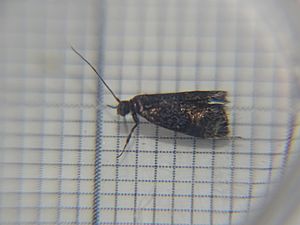Hierodoris stella facts for kids
Quick facts for kids Hierodoris stella |
|
|---|---|
 |
|
| Scientific classification | |
| Kingdom: | |
| Phylum: | |
| Class: | |
| Order: | |
| Family: |
Oecophoridae
|
| Genus: | |
| Species: |
H. stella
|
| Binomial name | |
| Hierodoris stella (Meyrick, 1914)
|
|
| Synonyms | |
|
|
Hierodoris stella is a special kind of moth that belongs to the Oecophoridae family. This moth is found only in New Zealand, which means it is endemic to that country. The New Zealand Department of Conservation has listed it as "At Risk, Relict," meaning it needs protection.
Contents
Discovering the Hierodoris stella Moth
This moth was first officially described in 1914 by a scientist named Edward Meyrick. He studied a moth specimen found in a place called Kauri Gully in Auckland. The person who collected it was Stella Hudson, and the moth was first named Coridomorpha stella.
Later, in 1928, another scientist, George Hudson, included pictures and information about this moth in his book, The Butterflies and Moths of New Zealand. Then, in 2005, Robert J. B. Hoare decided that this moth actually belonged to a different group, the Hierodoris genus. The original moth specimen that Meyrick used to describe the species is kept safe at the Natural History Museum, London.
Where Does the Hierodoris stella Moth Live?
The Hierodoris stella moth is found only in New Zealand. You can find it in several regions, including Auckland, Taranaki, Hawkes Bay, Bay of Plenty, and Wellington. It has been seen in specific areas like Kauri Glen Reserve in Northcote and in Karori.
Life Cycle and Behavior of the Hierodoris stella Moth
Scientists don't know much about the early life stages of this moth, like what its larvae (caterpillars) look like or what they eat. We do know that the adult moths are usually seen flying around in January and February.
An interesting fact about the female Hierodoris stella moth is that it seems to pretend to be a different insect when it's resting or walking. George Hudson noticed that it looks a lot like a bug called Romna capsoides. The moth's antennae and how it holds its body make it look very similar to this bug. Scientists think this is a clever way for the moth to protect itself. The bug it imitates has a bad taste and smell, so predators might avoid the moth, thinking it's the unpleasant bug.
What Does the Hierodoris stella Moth Eat and Where Does It Live?
We don't yet know what plants the caterpillars of H. stella eat. This is called their "host species." However, we do know that the adult moths prefer to live in forest areas.
Protecting the Hierodoris stella Moth
The Hierodoris stella moth is listed under the New Zealand Threat Classification System as "At Risk, Relict." This means that its population is small and it needs help to survive and thrive in New Zealand's forests.
Images for kids



